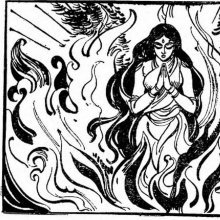Fire: 3 definitions
Introduction:
Fire means something in Hinduism, Sanskrit. If you want to know the exact meaning, history, etymology or English translation of this term then check out the descriptions on this page. Add your comment or reference to a book if you want to contribute to this summary article.
Images (photo gallery)
(+32 more images available)
In Hinduism
Yoga (school of philosophy)
Source: ORA: Amanaska (king of all yogas): A Critical Edition and Annotated Translation by Jason BirchFire refers to one of the “five elemental powers” and represents one of the various signs and paranormal powers (siddhi) experienced by the Yoga practicioner, according to the Amanaska Yoga treatise (presented in the form of a dialogue between Īśvara and Vāmadeva).—The last fifty-two verses of the Amanaska’s first chapter describe a temporal sequence of psychosomatic signs and paranormal powers (siddhi) brought about by absorption (laya). In the Amanaska, The five elemental powers are, [e.g., fire (tejas-tattva)], [...].

Yoga is originally considered a branch of Hindu philosophy (astika), but both ancient and modern Yoga combine the physical, mental and spiritual. Yoga teaches various physical techniques also known as āsanas (postures), used for various purposes (eg., meditation, contemplation, relaxation).
Shilpashastra (iconography)
Source: Shodhganga: Elements of Art and Architecture in the Trtiyakhanda of the Visnudharmottarapurana (shilpa)Fire is associated with Agni (Vahni), whose iconography is described in the Viṣṇudharmottarapurāṇa, an ancient Sanskrit text which (being encyclopedic in nature) deals with a variety of cultural topics such as arts, architecture, music, grammar and astronomy.—Vahni is the synonym of Agni. In the Viṣṇudharmottarapurāṇa the word vahni is used to denote the god Agni. According to the Śabdakalpadruma, Agni is the god who possesses fire in him as he is born from fire. In the agnisūkta of Ṛgveda, Agni is called as Aṅgiras. Thus it is clear that the Viṣṇudharmottarapurāṇa offers a great field of knowledge regarding the nuances of Indian art of Image making [e.g., fire] during 10th–11th century A.D.

Shilpashastra (शिल्पशास्त्र, śilpaśāstra) represents the ancient Indian science (shastra) of creative arts (shilpa) such as sculpture, iconography and painting. Closely related to Vastushastra (architecture), they often share the same literature.
General definition (in Hinduism)
Source: Shodhganga: Elements of Art and Architecture in the Trtiyakhanda of the Visnudharmottarapurana (h)Fire is used for conveying the offerings to the deities by making use of Fire altars.—The Hindu temples are designed for the purpose of making connection between man and the divine and to help the people to develop their spiritual knowledge and truth. From almost all accounts, it comes up that the origin of Hindu temples goes far back to those fire altars, which were used for conveying the offerings to the deities through fire, sacredly energized by chanting the holy mantras of the Vedic time. [...] In the Śatapathabrāhmaṇa it is stated that by worshiping fire in the Vedic age, the devotees or the sages obtained saṃvīd i.e., the entire earth and as because they were able to obtain this entire earth by it, therefore the, sacrificial ground is called vedī.
See also (Relevant definitions)
Starts with (+9): Fire altar, Fire birch, Fire bush, Fire cherry, Fire dragon, Fire Element, Fire God, Fire leaf, Fire lily, Fire oblation, Fire on the mountain, Fire plant, Fire sticks, Fire thorn, Fire-berry hawthorn, Fire-flame bush, Fire-thorn karree, Fire-worship, Fireball, Fireberry hawthorn.
Ends with: Digestive fire, Fire Element, Internal fire, Mengi fire, Setting fire.
Full-text (+7786): Agni, Pancagni, Anala, Ahavaniya, Agnihotra, Jvalana, Garhapatya, Arani, Agnyadhana, Dava, Agnitraya, Homa, Agnyadheya, Vahni, Agneya, Treta, Kunda, Agnihotrin, Pavaka, Dakshinagni.
Relevant text
Search found 469 books and stories containing Fire; (plurals include: Fires). You can also click to the full overview containing English textual excerpts. Below are direct links for the most relevant articles:
Satapatha-brahmana (by Julius Eggeling)
Kāṇḍa X, adhyāya 5, brāhmaṇa 3 < [Tenth Kāṇḍa]
Kāṇḍa IV, adhyāya 6, brāhmaṇa 8 < [Fourth Kāṇḍa]
Kāṇḍa II, adhyāya 1, brāhmaṇa 2 < [Second Kāṇḍa]
Brahma Sutras (Shankara Bhashya) (by Swami Vireshwarananda)
Chapter III, Section III, Adhikarana XXIX < [Section III]
Chapter III, Section III, Adhikarana I < [Section III]
Chapter III, Section IV, Adhikarana V < [Section IV]
Mahabharata (English) (by Kisari Mohan Ganguli)
Section CCXXI < [Markandeya-Samasya Parva]
Section CCXX < [Markandeya-Samasya Parva]
Section XVIII < [Asramavasa Parva]
Manusmriti with the Commentary of Medhatithi (by Ganganatha Jha)
Verse 11.65 < [Section VI - Offences: their Classification]
Verse 2.231 < [Section XXX - Rules to be observed by the Religious Student]
Verse 6.4 < [Section II - The Procedure to be adopted]
The Sacrifices of Rajasuya, Vajapeya and Ashvamedha (study) (by Aparna Dhar)
Brief description of three fire cavities or Agni-kuṇḍa < [Chapter 2 - Vedic Sacrifices described in the Śatapatha Brāhmaṇa]
Summary of the Agnyādheya Sacrifice < [Chapter 2 - Vedic Sacrifices described in the Śatapatha Brāhmaṇa]
Summary of the Punarādheya Sacrifice < [Chapter 2 - Vedic Sacrifices described in the Śatapatha Brāhmaṇa]
The Brahmanda Purana (by G.V. Tagare)
Chapter 12 - The race of Agni < [Section 2 - Anuṣaṅga-pāda]
Chapter 22 - Paraśurāma’s penance (a) < [Section 3 - Upodghāta-pāda]
Chapter 11 - Offering rice-cake (piṇḍa) to the Manes (Pitāmahas) < [Section 3 - Upodghāta-pāda]
Related products
(+12 more products available)











